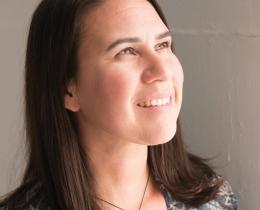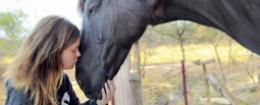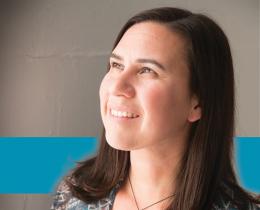1. Connect: Checking in With My Feelings
Take a quiet moment for yourself to investigate how you are feeling. Sit in a way that is steady and comfortable. Choose whether to put your hands in your lap, by your sides, or place a hand on your heart or your belly—whatever feels right to you. Focus on taking a few slow and steady breaths, and then ask yourself what emotions you are feeling right now.
You may notice that you are feeling more than one emotion, and this is perfectly normal. Sometimes you may feel two things at once, like lonely and angry, or embarrassed and frustrated. You may even feel two things that seem very different, like sad and happy or nervous and excited, at the same time! At other times it may be just one feeling that you notice showing up. Try not to worry about what is causing your feelings—it’s enough right now to just notice them.
Once you notice how you are feeling, you may be able to notice that your body responds to your feelings. For example sometimes we tighten our fists when we are angry, or our belly gets fluttery when we are nervous, or our eyes water when we are sad. Do you notice your body responding to your feelings today?
2. Breathe: Balloon Breath
Sit with your back straight and tall. Place your hands on your knees and start to breathe in and out through your nose. Imagine that your body is a balloon, and with each breath in you are filling yourself completely with air.
As you breathe in, arch your back, let your chest and belly soften and move forward, and look up. This is a modified form of cow pose. As you breathe out, pull your belly button in, round your back, and look down toward your belly. This is a modified form of cat pose. Repeat this movement and breath pattern several times, breathing in to fill up your body and breathing out to deflate it.
On your next inhale, open your chest, but this time bring your arms up and over your head as well. Make your body very big and full. As you breathe out, bring your arms back down and as you round your back and pull in your belly, wrap your arms around yourself in a hug. Continue for a few rounds, breathing in to fill yourself up and get very big, and breathing out to make yourself as small as you can be. With each exhale, try alternating which arm is on top during your hug.
3. Move: Simple Seated Sequence
Seated Sun Salutation: Explore this simple pattern of movement in the chair, taking the time to notice how the different shapes feel in your body. Try moving slowly for one round and then a bit faster the next, and choose a speed that feels good to you for a third and final round. 1. Inhale and reach your arms up. 2. Exhale and fold forward. 3. Inhale and flatten your back, but don't come up all the way. 4. Exhale and fold forward again. 5. Inhale, come up, and reach your arms up. 6. Exhale and relax your arms down, hands on your lap.
Boat Pose: Sit at the very front edge of your chair, and lean back just a bit, until you feel your core muscles working. Extend your arms out in front of you with your palms facing each other. Lift your chest, and bring one foot off of the ground, drawing your knee towards your chest. Hold for 3-5 breaths, then slowly lower your foot to the floor, keeping your spine long and your core engaged. Repeat on the other side and alternate legs a few times before bringing both feet to the ground. Sit up for a moment, then lean back again and lift both legs off the ground.
Seated Twist: Take a breath in and raise your arms overhead. As your breath out, gently twist to one side, bringing one hand behind you and the other hand to your opposite knee. Stay here for a few rounds of breath. Each time you inhale sit up a little bit taller. Each time you exhale, see if it feels good to twist a tiny bit further. When you’re ready, inhale and lift your arms to come back to the center, and then exhale over to the other side. Stay on the second side for the same number of breaths as you held the first side.
4. Focus: I Am So Strong
Combine the movement of your hands with a powerful statement or affirmation toward yourself. Begin by connecting your thumb to your pointer finger for “I,” your thumb and middle finger for “am,” your thumb and ring finger for “so,” and thumb and pinkie for “strong.”
Use enough pressure to feel the connection your fingers are making. Begin slowly, saying “I am so strong” using both hands simultaneously, and as you feel more comfortable you can go a bit faster. Experiment with what it feels like to say the statement out loud, versus saying it silently to yourself. Continue for as long as you would like, about 30 seconds is great to start, and when you are finished take a few slow breaths before you go on with your day.
You can always try out other statements as well, such as “I’m full of love”, “I am in charge”, “I can do this,” or anything else you think you need to hear.
5. Relax: Child’s Pose in a Chair
Hinge forward at your hips and bring your elbows onto your knees, thighs, or the desk in front of you. Bring the pinky sides of your hands together to make a shelf, and drop your forehead down into your hands, completely releasing the weight of your head. Take 5-7 steady breaths and let your body settle and rest. When you’re finished, slowly lift your head and notice how you are feeling.
Guiding Principles
- Chair yoga doesn’t always have to mean sitting. Be creative! Incorporate movement sitting in the chair, facing the chair, or standing behind or alongside the chair.
- Encourage children to listen to their body. If something doesn’t feel right, they should take a break, modify, or stop the activity. Practicing listening to the messages of the body is empowering, helps keep kids safe, and increases self-awareness and embodiment.
- Ask questions to encourage kids to mindfully explore sensations in the body during movement. Some examples are: What part of your body is working right now? What parts are resting, tensing, relaxing, or stretching? What messages is your body sending you? Can you notice any thoughts? What is your mind telling you? How are you feeling right now? Has how you are feeling changed since doing the activity?








